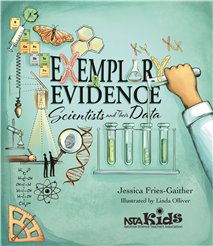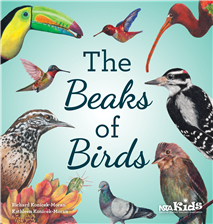Books Your Young Readers Will Want to Open and Explore
By Carole Hayward
Posted on 2019-01-25
Engaging students in crosscutting STEM concepts is made so much easier when talented storytellers and gifted illustrators produce the kinds of books that young readers immediately want to open up and explore.
In Richard Konicek-Moran’s and Kathleen Konicek-Moran’s latest NSTA Kids’ book, The Beaks of Birds, readers are encouraged to accompany Mr. and Mrs. Hernandez on a journey, one that takes them from the back yard, into the park, past a pond, and through the pages of a photo album, to understand how birds use their beaks to find and capture their food, survive, and even defend themselves.
This book will surely help encourage a whole new generation of birders and future biologists as readers are introduced to nearly 20 different birds from house finches, to Eastern wood pewees, black skimmers, glossy ibises and roseate spoonbills, just to name a few. The Hernandezes make this learning fun by issuing the following challenge to readers: Figure out what each bird eats by the shape of its beak, which is also a great way to introduce students to the crosscutting concept of structure and function.
Eight kid-friendly activities as well as lots of fascinating background information are included at the end of the book to supplement learning, both in the classroom and at home. Students are encouraged to do things like examine the shape of a kitchen tool to understand how it helps it do the job for which it was intended; put up a backyard bird feeder and keep track of the different types of birds that frequent it throughout the year and what they like to eat; research an organization that helps protect birds and determine what they can do to help; and draw a picture of a tool they would like to have that would help them do something they want to do.
 Exemplary Evidence: Scientists and Their Data
Exemplary Evidence: Scientists and Their Data
Jessica Fries-Gaither uses rhymes in her latest NSTA Kids book, Exemplary Evidence: Scientists and Their Data, to get her young readers to think of science as puzzles to be solved. Illustrator Linda Olliver’s wonderful drawings help bring Fries-Gaither’s whimsical rhymes to life as well as help introduce readers to the work of a diverse group of scientists spanning history to present day. Students learn about the work of Maria Sibylla Merian, Carlos Juan Finlay, and Russell Stands-Over Bull, for example. They are also encouraged to extend their learning beyond the pages of this book by understanding how to collect their own data/find their own answers to how the world works using four easily understood steps.
Exemplary Evidence makes the collecting, organizing, comparing, sharing, interpreting, visualizing, analyzing, and mapping of data fun! In the words of Fries-Gaither:
“The importance of data is shown rather well
by the work of scientists—too many to tell!
Throughout all of history, data’s been key
In the making of every great discovery.”
Learn more about the NSTA Kids series, which are trade books dedicated to nurturing the wonder and curiosity inherent in young minds.
Follow NSTA
Disclaimer: The views expressed in this blog post are those of the author(s) and do not necessarily reflect the official position of the National Science Teaching Association (NSTA).



